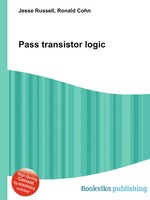Pass transistor logic
Jesse Russell Ronald Cohn
бумажная книга
High Quality Content by WIKIPEDIA articles! In electronics, pass transistor logic (PTL) describes several logic families used in the design of integrated circuits. It reduces the count of transistors used to make different logic gates, by eliminating redundant transistors. Transistors are used as switches to pass logic levels between nodes of a circuit, instead of as switches connected directly to supply voltages. This reduces the number of active devices, but has the disadvantage that output levels can be no higher than the input level. Each transistor in series has a lower voltage at its output than at its input. If several devices are chained in series in a logic path, a conventionally-constructed gate may be required to restore the signal voltage to the full value. By contrast, conventional CMOS logic always switches transistors to the power supply rails, so logic voltage levels in a sequential chain do not decrease. Since there is less isolation between input signals and outputs, designers must take care to assess the effects of unintentional paths within the circuit. For proper operation, design rules restrict the arrangement of circuits, so that sneak paths, charge sharing, and slow switching can be avoided. Simulation of circuits may be required to ensure adequate performance.


